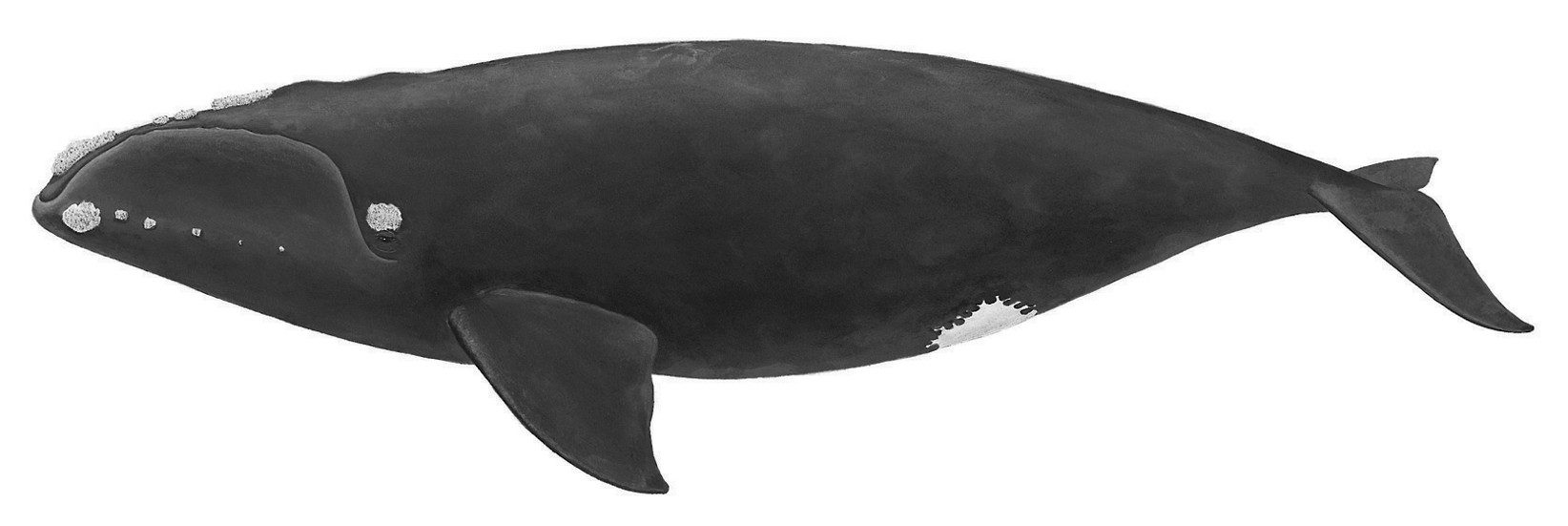NORTH ATLANTIC RIGHT WHALE
Eubalaena glacialis Müller 1776
Order Cetacea : Family Balaenidae
DESCRIPTION. A large, blackish whale with the following features: no dorsal fin; head huge, about one-fourth of total length; baleen (whalebone) about 2 m long, 30 cm wide, and between 200 and 250 plates in number on each side of mouth; closure of mouth highly arched; no furrows on the throat; prominent, large, wart-like areas (called bonnets), the one near tip of snout largest. Total length of adults, 14–17 m; weight, 20–30 metric tons.

DISTRIBUTION. Worldwide in distribution but extremely rare. Only 3,000–4,000 remain in the world's oceans, with about 300 constituting the North Atlantic population. Known in Texas from a single individual that beached in February 1972 at Surfside Beach near Freeport, Brazoria County.
SUBSPECIES. Eubalaena g. glacialis.
HABITS. Right whales were so named by early whalers because they were the right whale to kill;
they are slow swimmers and were thus easily caught, floated when dead, and produced
large quantities of oil and baleen. Consequently, right whales were decimated early
by the world's whaling industries and have yet to recover.
Right whales spend spring, summer, and autumn at high-latitude feeding grounds and
migrate to more southern, warmer waters in winter for mating and calving. Northern
and southern populations do not interbreed because the seasons of the two hemispheres
are asynchronous.
Right whales produce a variety of vocal sounds as well as percussive sounds of breaching, flipper slapping, and tail slapping. A distinctive clacking sound has been described for these whales as they feed at the surface. Termed the baleen rattle, this sound is produced by small wavelets rattling the baleen plates when they are held partially out of water. Right whale sounds appear to differ with changing behavior and, thus, may be important in communication. Right and other baleen whales probably do not echolocate.
Right whales produce a wide, V-shaped blow when exhaling, and the tail flukes tend to show before deep dives. These whales have broad tail flukes that are deeply notched medially and are dark colored above and below. The trailing edge is not serrated, unlike the tail of the humpback whale.
Right whales feed by skimming through concentrations of krill. They have been seen feeding at depths ranging from the surface down to 10 m, although they may also feed at deeper levels. Location of krill concentrations in the water column probably determines feeding depth.
After a 1-year gestation period, females give birth to a single calf in winter. Mature females give birth at 3–7 year intervals, and the age of first calving seems to be about 7 years. Calves are 5–6 m in length at birth but grow rapidly during the subsequent period of lactation, which lasts about 13 months. Calves remain with their mothers for 2–3 years following weaning and probably reach sexual maturity at about 10 years of age.
POPULATION STATUS. Extralimital; stranding. North Atlantic right whales occur only accidentally in the Gulf of Mexico, and this is certainly one of the rarest of cetaceans in these waters. The central Gulf may have been a whaling ground for right whales in the 1880s, but nothing is known of that reputed whaling effort. There has been only one stranding along the Texas coast.
CONSERVATION STATUS. The USFWS and IUCN list the North Atlantic right whale as endangered; it is not listed by the TPWD. According to the IUCN, the major decline for this species began more than three generations ago. The number of reproductively active females in the western North Atlantic was determined to be 70 animals in 1998, which is well below the endangered threshold of 250.
From The Mammals of Texas, Seventh Edition by David J. Schmidly and Robert D. Bradley, copyright © 1994, 2004, 2016. Courtesy of the University of Texas Press.
Natural Science Research Laboratory
-
Address
Museum of Texas Tech University, 3301 4th street, Lubbock, TX 79409 -
Phone
806.742.2486 -
Email
nsrl.museum@ttu.edu

